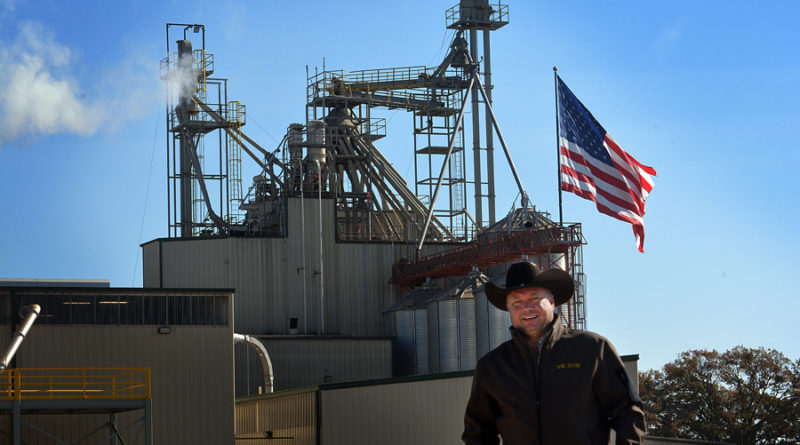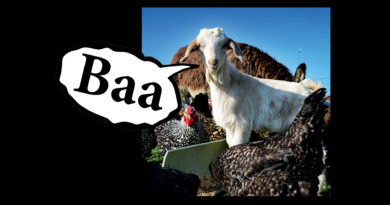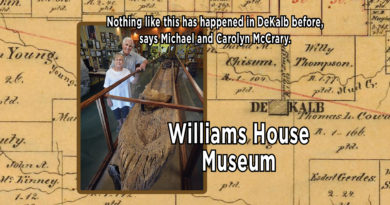Mid American Pet Food Gives Flight to Dreams
In the American pet food market, “extruded proteins are where the excitement’s at,” said Mid America Pet Food General Manager Antoine Albin.
Not an easy line to deliver with a straight face, but starting at zero and growing to accounts in 48 states in ten years makes it possible.
The process of extrusion maximizes the digestible protein potential of ingredients. Add the highest quality ingredients on the market and you get the highest quality products in the market. In the Mid America business plan, quality is first. Marketing follows. Success has ridden development of the company’s high-end Victor dog food line beginning the day Mr. Albin and company founder Scott Glover came to terms. A retired college professor, Dr. Jim Tollet triggered the connection between Antoine Albin and Scott Glover that became the cornerstone for Mid America Pet Food’s soaring from start up to a national brand in a ten year time frame.
Six months later, on August 18, 2007, “we flipped the switch and began production,” Mr. Albin said. “Those first six months, we were out here welding and bolting and putting together the production line Scott spent three years fabricating in the shop in his back yard.” While building the mill, Mr. Glover moonlighted as a corporate pilot.
Including Mr. Glover and Mr. Albin, a total of five employees ran the production line the first day. Today, there are 117 employees.
From the year the doors opened, construction has been un-ending. Based on projections drawn from study of the graph tracking the history of the business to date, they’ll need 300 employees and be out of land within three to five years so they’re negotiating on a second plant location while expanding their first. The results are tangible.
At 51, Mr. Glover bought his first new car. And he’s built the Mid America Flight Museum, the Mt. Pleasant home of some 40 vintage planes restored to museum perfection, most of them World War II era “war birds.”
“There’s not another place like this,” said Nick Viggiano, adding, “anywhere,” to emphasize his point. A freelance writer and photographer, he writes mostly for “In Flight USA.” “All these planes fly,” he said. “Most places, they don’t want you touching the exhibits. Planes sit inside velvet ropes. Here, the docents will help you climb in the cockpit.”
A lot of the docents, all volunteers, are other pilots flying in to work the museum’s Saturday hours. In recent months, Mr. Glover has been more involved with the opening of US Roast, managed by Martin Rojas, who is training Sam and Will Burrows to roast coffee beans. The process is a blend of art and science targeting the critical point at which any given coffee bean releases its maximum natural flavors. Around the world, coffee is grown along the earth’s tropical belt with the characteristics of beans dependent on the microclimate determined in part by elevation and rainfall plus soil types. Each element factors into the potential defined by a flavor profile specific to the place of the bean’s origin. Roasting breaks down cell walls releasing flavors specific to each bean at the critical point of the “second crack.” It’s a mix of science and art. Seconds matter. A heartbeat beyond the second crack breaks into a “dark roast” where the bean begins losing its varietal characteristics. “Dark Roast” is a mass production technique in which beans from anywhere may be poured into the mix and roasted to uniformity, a cost-saver. US Roast is less about cost and more about the variety of “origin specific” beans roasted to their height for flavor. Similar to the excitement of extruded proteins in milking the most from pet food ingredients, the science of roasting coffee beans at US Roast is visually followed by a computer tracking time on one axis and temperature on the other to produce a moving graph programmed to match the flavor profile specific to any bean from anywhere on the planet. The art of it is dependent on the senses, recognizing the changing release of aromas as beans roast breaking down cell walls, listening for the “second crack” of the outer skin, the point at which the bean releases its height of the natural flavors reflecting the soil type and micro climate of its origin. Got it?
Less than a year into production, US Roast serves a growing line of independent coffee houses and is developing and producing products for private label sales. They’re roasting beans from 14 countries, perfecting processes in a development facility while building a 21,000 square foot plant at U.S. 271 South and Airport Road. Antoine Albin and Scott Glover met in a log cabin in Arkansas in the 1990’s.
“Not really a cabin, but an old wooden feed mill called T Square Feeds built in 1922,” Mr. Albin said. They produced pelletized – not extruded – lines of horse, cattle and chicken feeds, milking all they could from technology so ancient it was challenging to run efficiently at anything less than maximum production.
After that, they didn’t see each other for seven years. In the interim, Mr. Albin began a trucking company that grew from one truck to 21, then sold out to pursue his new interest in teaching.
“The only time in my life I’ve ever voluntarily switched gears was when Scott called and told me he was building a feed mill,” Mr. Albin said. “He didn’t have any money. I signed on for $20,000 a year because I know him and I’d seen him in action. While Scott’s talking to you about one thing, his mind’s running downfield thinking about what comes next.”
A one-time high school quarterback for the Albany, Louisiana Hornets, Mr. Albin came of age in a family operation running cattle “on the tallest hill in South Louisiana,” a rare place because it rarely flooded.
His love of cattle caused his collegiate career in agriculture, which put him in the feed mill business. Mr. Albin and Mr. Glover are partnered up in a trucking enterprise, SGAA Logistics. Mid America Pet Food is their anchor customer. They’re partners in a 500-head mama cow-calf operation, too.
After things got going good, Mr. Glover taught Mr. Albin to fly.
“Scott believes everybody should know how to fly,” Mr. Albin said. The flight instructor who signed off on Mr. Glover’s instrument rating before he was out of his teens described Mr. Glover’s passion for flight another way.
“Scott Glover could fly a brick,” said the late Albert Neal.
Back on earth, the Mid America Flight Museum at the Mt. Pleasant airport isn’t a money maker. It’s a passion reflected in its hosting the last two annual reunions of the fading gathering of the World War II Glider and Troop Carrier Pilots Reunion. Last year, there were 24 who attended two days of flying and catered meals culminating with a Saturday night featuring the Glenn Miller Orchestra from the 40’s era of Big Bands.
This year, there were a dozen veterans who made the trip to Mt. Pleasant.
“The planes are marvelous, the military technology of an era that saved the free world,” Mr. Glover said. “But without the people who love them, they’d be nothing. At the end of the day, it’s less about the planes and more about the people. “That’s what life’s about – people,” he said.




